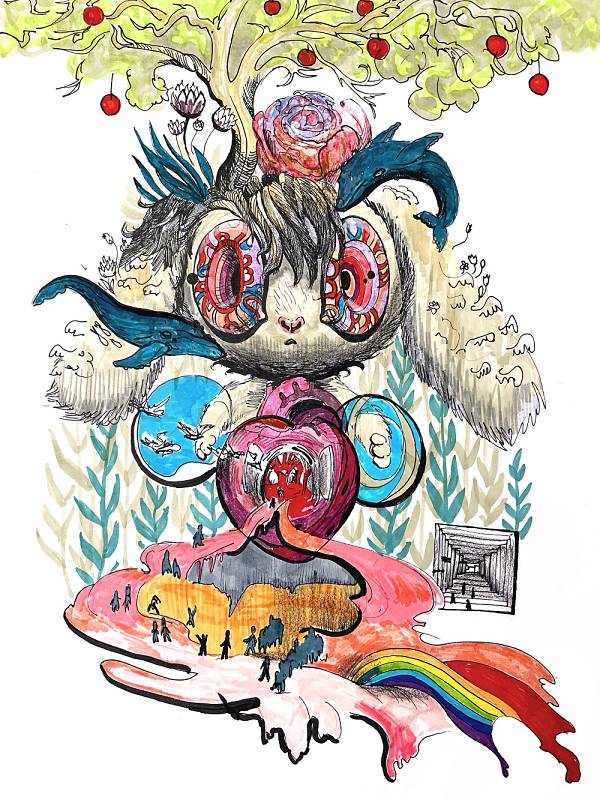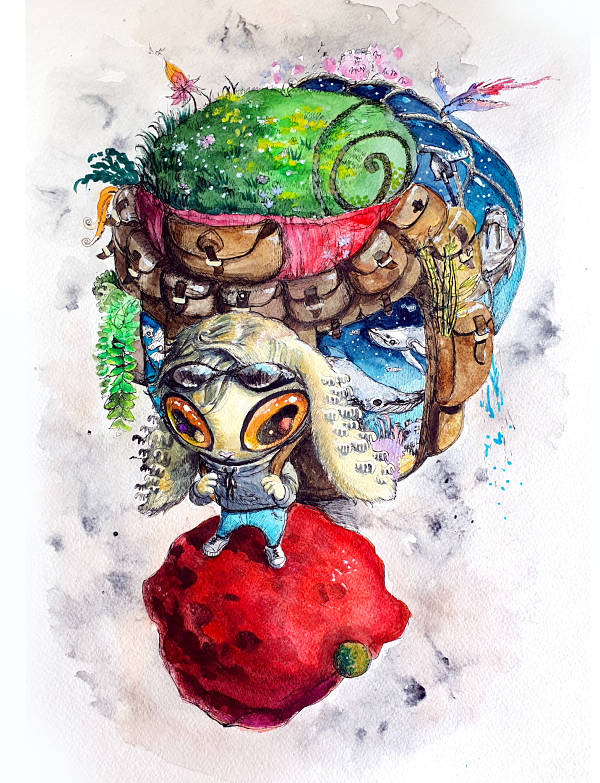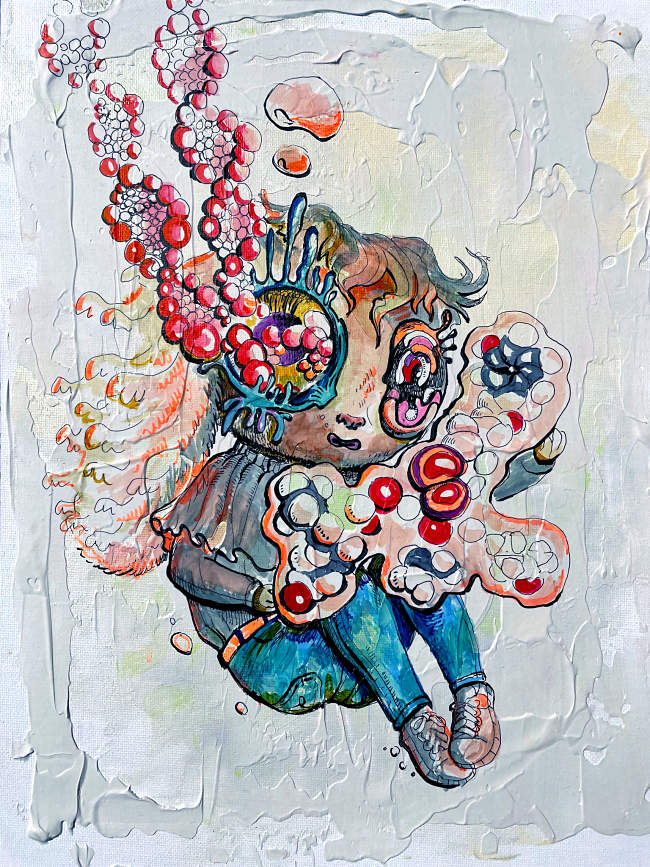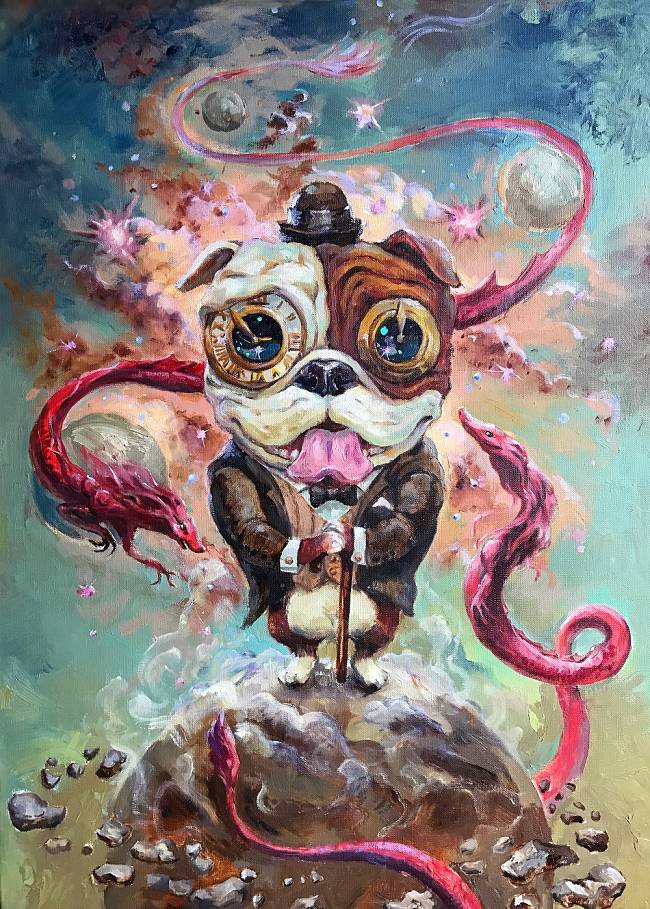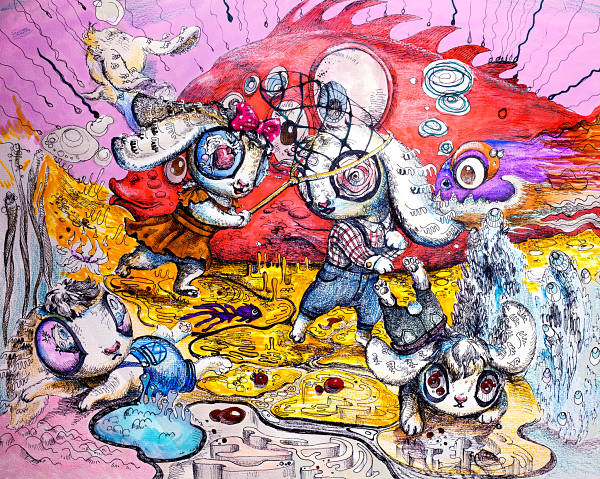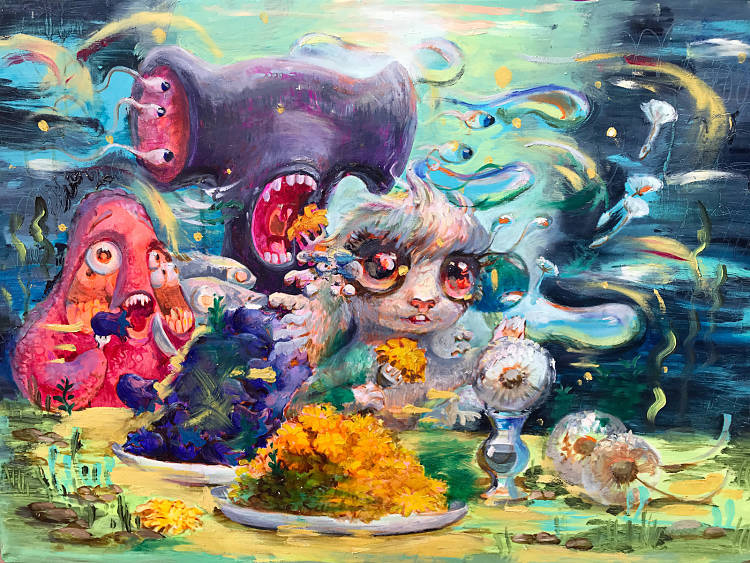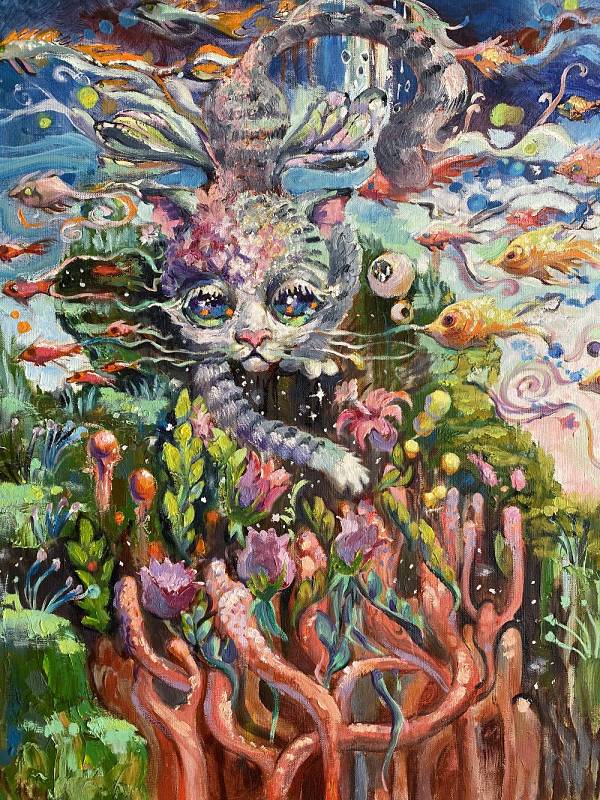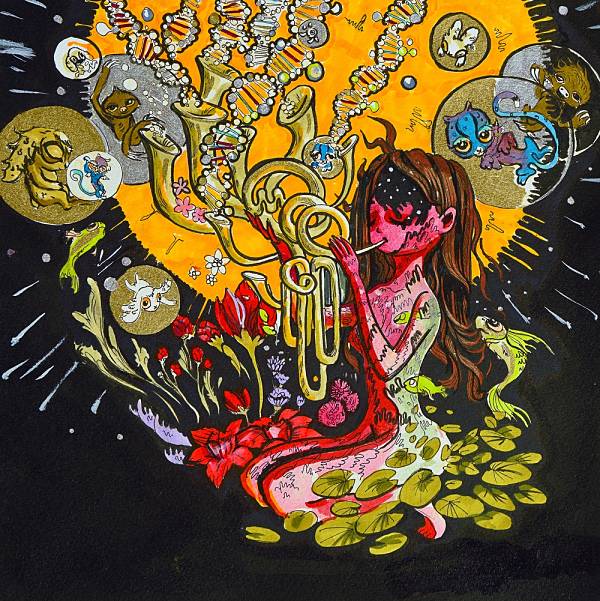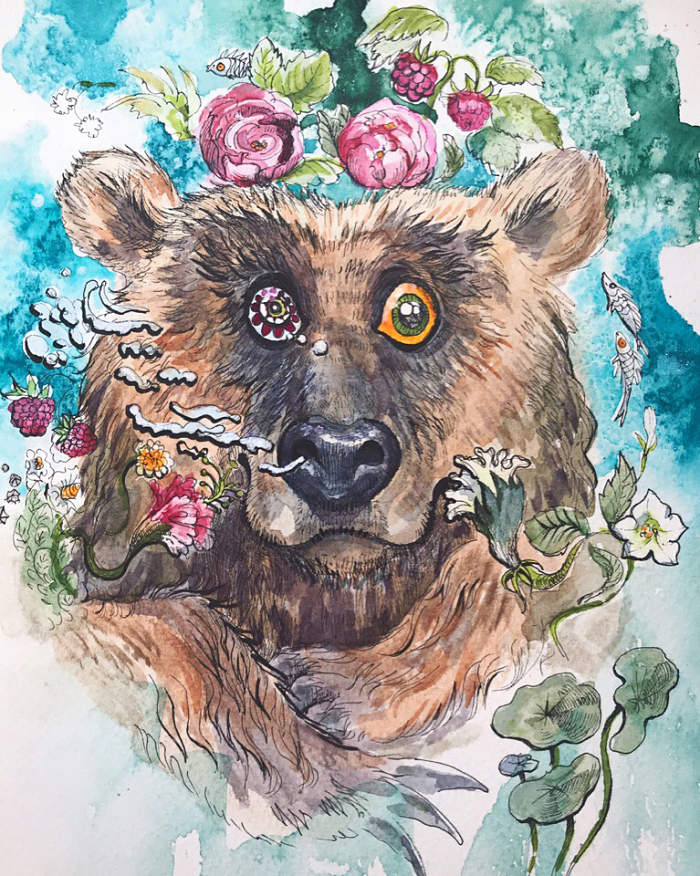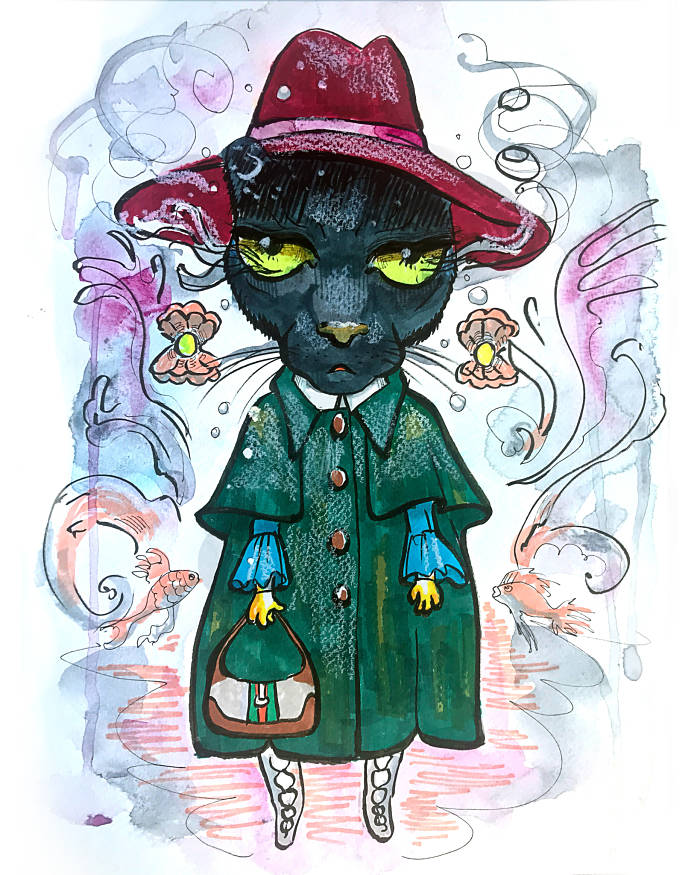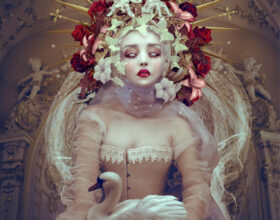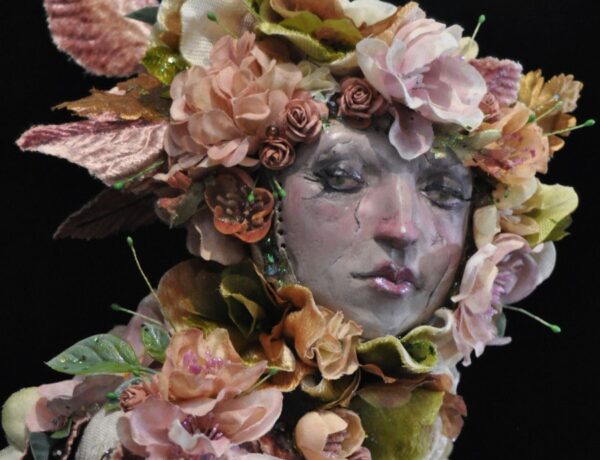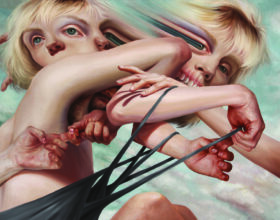Come with us and take a trip to the other side, where notions of growth and teatime conversations walk the summit of enchantment with a smile. Unfurl the painted layers and traverse the fanciful realms of Zoya Koinash and her wildly surreal dexterity. Laced with dreamlike symbolism, the juxtapositions of storytelling leads you down a path of vibrant palettes, intriguing compositions, and magical creatures… each waiting for you to share the adventure as if guardians of her artful wanderlust. Creating contrasts, her characters emphasize an innate connection to their place within Zoya’s universe and to the blurred lines of their enticing wonderland.
Steeped in fantasy, Zoya Koinash is no stranger to artistic experimentation. Working with a variety of mediums, her visionary style and distinct interpretations allow us, the curious viewer, to explore the depths of her creativity. Embark upon the dreamy elements of her work and get swept away in the beguiling narratives and textured brushwork that align the stars of her imagination, and yours.
I wanted to create a universe where the laws we are used to do not work. I called it Antigravity Style.
Zoya Koinash Biography // Painter, illustrator, and digital artist Zoya Koinash creates special aesthetics of surrealistic world with cute and a bit creepy creatures filled with reflection. The study of quantum physics and microbiology has influenced the perception of space, form and way of thinking and the artist is not limited to classical perception of forms and techniques.
During her early years, she studied insect biology and microbiology, all materials available in the provincial library of the village in which she grew up. Therefore, the organic forms are one of the main elements of the artist’s work. She attended the School of Art in Ross Township in 1996-2000 and participated in local exhibitions of artists.
Between 2000-2006, she studied at the Minsk State Medical University, where she continued studying biology, microbiology and other disciplines. For a long time the artist studied and was impressed by the works of the Impressionists, Van Gogh, Claude Monet, Pierre Auguste Renoir. After living in Buenos Aires she was extremely impressed with Antonio Berni, and started studies contemporary art. Zoya Koinash has worked as an illustrator and digital artist since 2004, for companies making games. In 2017, she began painting with oil. The oil painting became immediately close to the artist, and in it she finds many similarities with the digital environment native to her. Also she uses watercolors, acrylic, ink, markers, brush pens and liners.
Interview with Zoya Koinash
Dreamy, vibrant narratives play a pivotal role in your artwork, taking the viewer on an adventure into your imagination. How would you describe your artistic style and how do you maintain your creative vision?
I consider my style of thinking to be visionary; I believe that this is due to the peculiarity of my brain. It is easy for me to imagine any scene from life in a phantasmagoric, narrative way, where a lot is happening at the same time. If I was born in the Middle Ages, I would be like-minded to the likes of Bosch; in the modern world, I keep his traditions of symbolism and allegory. If we talk about my painting style, then this is a space in which all scales are present at the same time: planets, stars, fantastic creatures, tissues, cells, organelles and molecules. Initially, I wanted to create a universe where the laws we are used to do not work. I called it Antigravity Style.
My travels around the world have made my heroes multicultural and open to new experiences.
What part of yourself do you feel is most incorporated into your work?
This is the curious, creative and emotional part of me. As a child, I was interested in a lot; I read all the books in the local library, except for “Capital” by Karl Marx. We lived in a military town in the outback of Belarus, and there were no other children of my age. How else could a curious, sociable child have fun if not invent something themselves, walking through the forests and swamps in their own company? It was then that I realized that in creativity I share my emotions and express it much easier than in life. This has a therapeutic effect for me.
Another thing that influenced me was working on a training program for individuals with certain handicaps. I had to constantly look for new solutions in order to visualize what was difficult to express in words, feelings, and abstract concepts.
If we talk about how I became an artist, I was influenced by many paradoxes and adventures that happened to me. For example, molecules and organelles that are often present in my paintings are what remained after studying at a medical school and working as a doctor. My travels around the world have made my heroes multicultural and open to new experiences. Working in game development influenced my color palette.
The character I draw the most is hypnobunny. He is so paradoxical, simultaneously observing everything that happens… such a fearless bunny looking for adventure.
Your protagonists breathe life to each of your creative renderings. Do you have a favorite character? If so, what sets that one apart from the others?
My favorite character in literature and cinema is the mad scientist; this image for me is endowed with a romantic appeal. It is found in the Amphibian Man, in Doctor House and in Rick and Morty. The principle thinking of this hero, I laid in one of the Universes of the World that I drew, and each character studies some phenomenon and is modified in accordance with his subject of study. The character I draw the most is hypnobunny. He is so paradoxical, simultaneously observing everything that happens… such a fearless bunny looking for adventure.
I associate him most with myself; he wants to understand the structure of this world, is in love with it, so he is not surprised at its complexity and unpredictability, for him there is always more than one point of view, he is independent in his conclusions, experiments.
Can we delve into and discuss your painting method, most employed tools, and artistic methods. How does a painting begin?
Oil reminds me of the digital environment that I used for many years when I worked as a 2D artist for games. You can work with layers, fix any mistake and, in general, oil is a very plastic material. The paradox is that the digital painting environment is designed to mimic traditional materials. Of course, it is important for me that the materials are of high quality and do not lose their properties over time. There are favorite brushes – cosmetic, with soft bristles.
Do you have any specific techniques and how long does it take to complete your vision?
Principally, I work in the layers. It takes about a month to create a picture about a square meter in size. Since I cannot paint one picture every day, I have to put it off and take on another and create a few in parallel.
My drawing method can be called intuitive and mostly I work impromptu, relying on my imagination.
And how has it evolved over time?
Yes, the technique changes over time. At first, I used oil paints and linseed oil in my works. For me it was a guarantee of its durability. However, then I realized that modern high quality materials open up new possibilities, so now I also use acrylic. I like to add textures and various effects.
In a similar vein, what is your mental process vs. creative process when preparing each painting?
My drawing method can be called intuitive and mostly I work impromptu, relying on my imagination. And when I want to go deeper into some specific topic, I study references and do research on the topic.
Describe a place (your favorite place) that has become inspirational to the creation of your artwork.
I have to paint in different places. The best places are where nothing distracts me, because I have three children. Now my studio is in the garage, and in good weather I paint in the garden.
What’s your favorite thing to do outside of the art studio?
Most of all, I love to dive or snorkel in the warm ocean… looking at fish, corals, and wrecks. When there is no such opportunity, I like to do what I haven’t done yet and go somewhere where I haven’t been.
You work with a variety of mediums like oil, watercolors, acrylic, ink, markers, brush pens and liners… are there other materials you’d like to try but haven’t attempted just yet?
Yes, first of all I want to work with cold porcelain. I have some ideas for creating sculptures. 9 kg of porcelain are already on my table in the workshop and waiting in the wings.
Will you tell us about your recent exhibition, “VISIONARIUM”, and your plans for the rest of the year ahead? What do you hope to accomplish… if you could foretell the future, what do you see on the horizon?
This exhibition, which took place in Valencia from April 13 to May 7, showed part of my paintings from the Depth Series and some other works created from 2017 to 2021. There was also one picture that I decided to remake; unable to bear the difficult memories associated with it, I covered it partially with the canvas primer and then decided to ask the visitors of the exhibition to help finish it in support of people who are fighting for freedom and justice.
Since the beginning of the year, I have already participated in five exhibitions, so for the second half of the year I plan to work on a new series. It’s a project related to the perception of time has taken shape in my head. I want to explore the idea in different sciences and tell a personal story related to the perception of time. And, of course, I will continue to work on developing my art and describing its universes and characters.
I have big plans; the release of a series of comics, the launch of merchandise, and the construction of an educational platform for my universes, which allows visualizing such processes in the human body. For example, chromosome duplication and the work of the hormone of happiness receptors.





